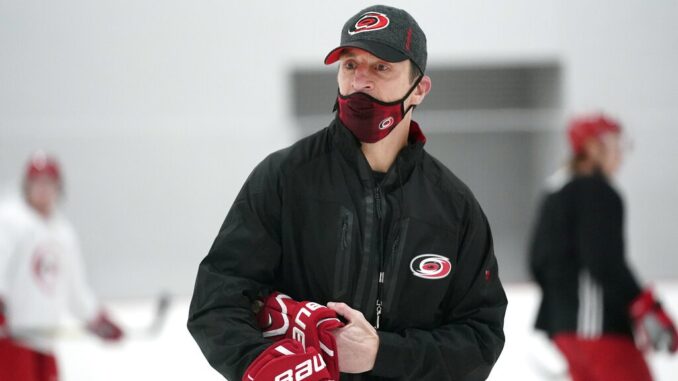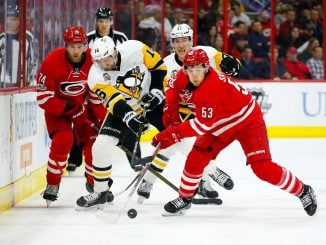
RALEIGH — Hockey’s back, but even for the most knowledgeable fans who track player movement, keep tabs on which coaches land where, analyze and fret over the draft, and scour the salary cap for loopholes that can benefit their favorite team, the 2020-21 season will require a bit of a learning curve.
Much like last year’s return-to-play procedures that added five-game play-in series and took place in two bubbles, there again won’t be fans in most arenas when the season opens Wednesday. But there are a lot of other tweaks the NHL and NHLPA have implemented to try and have a successful, albeit shortened, season.
The schedule
The league will play just over 68% of the regular season games it would normally, going from the standard 82-game schedule to an abbreviated 56-game slate. There are also reconfigured divisions to minimize travel and accommodate Canadian teams who cannot shuttle across the border over and over.
The Hurricanes are in the Central Division for this season along with Chicago, Columbus, Dallas, Detroit, Florida, Nashville and defending Stanley Cup champion Tampa Bay. Teams will only play against the other teams in their division during the regular season. In the Central, that means Carolina will play eight games each against its seven Central opponents, totaling 56 games.
The Hurricanes planned outdoor game at NC State’s Carter-Finley Stadium has been pushed into the future due to the ongoing pandemic. As of now, all games at PNC Arena will be played without fans.
The playoffs
Despite the fewer divisions, the same number of teams will receive playoff berths, but how they will be awarded and the structure of the Stanley Cup Playoffs will change.
Normally, the top-three teams in each division would earn a playoff spot with the two remaining teams in each conference with the most points earning a wild card. This season, each division will yield four playoff teams (no wild cards), and those four teams will play each other (top seed vs. fourth; second seed vs. third) in the first round of the playoffs.
Then, the two remaining teams from each division would play in the second round to reach the semifinals. Final four opponents will not be determined by conference — the team remaining with the most regular season points will face the team with the fewest points, and the other spot in the Stanley Cup Final will be determined by a matchup between the two remaining teams with the second- and third-most points.
Taxi squads
Don’t understand how the NHL’s waiver system works? Well, things just got even more confusing.
The NHL, in an effort to have more players available to teams without further disrupting its cap system and to avoid potential issues with COVID-19, will allow its teams to have a taxi squad of AHL players that live and practice in the NHL city but still be mostly regarded as AHL players.
The taxi squads will be between four and six players, and players who would require waivers to be sent to the AHL (for example, Joakim Ryan needs to pass through waivers, Jake Bean does not) would need to do so to be placed on the taxi squad.
Unless a team has three goalies on its NHL roster, each taxi squad must have at least one goalie, and he is the only player who will be required to travel with his NHL team on the road since there will be no emergency goalies (sorry, David Ayres) in arenas this season. The rest of the taxi squad may travel with the team but isn’t required.
The taxi squad players will earn the same salary they would if they were with the organization’s AHL team and count the same against the salary cap as if they were assigned to the AHL.
Decisions on who will make up a taxi squad should be interesting, as NHL teams will want their best players available as fill-ins for their roster in case of injury or COVID-19 protocols but also not minimize the game action of developing players.
If a team wishes to add a player from its AHL team to its taxi squad, the player must quarantine for seven days. The three Canadian teams whose AHL affiliates are in the United States (Calgary, Edmonton and Vancouver) would have to wait 14 days due to Canadian mandates on border crossing.
More rules
There is one on-ice rule change for the 2020-21 season. The offside rule that required a player to have one skate touching the blue line or outside the zone is gone, and players will now just be required to have broken the plane of the blue line to stay onside. The league says 14 goals last season were wiped out because of the old rule.
Salary bonuses will be prorated — both in benchmarks and payouts — and any rookie who plays seven games, rather than the usual 10, will burn one year of their entry-level contract.
COVID-19 rules will be everywhere. You’ll have to imagine Carolina coach Rod Brind’Amour and new Washington coach Peter Laviolette chomping on their gum this season because all coaches will be required to wear masks.
Players, coaches and staffs will be pretty much confined to their hotel rooms on the road, and each player will receive their own room even if they haven’t reached the CBA’s threshold for seniority. And team-building will certainly be difficult as the NHL is encouraging teams to hold as many virtual meetings as possible and players to avoid contact with each other.



